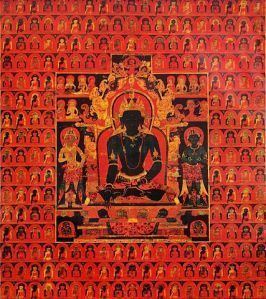 | ||
In praise of dharmadhatu class one
Dharmadhatu (Sanskrit) is the 'dimension', 'realm' or 'sphere' (dhātu) of the Dharma or Absolute Reality.
Contents
- In praise of dharmadhatu class one
- In praise of the dharmadhatu by nagarjuna
- Definition
- Historical origin
- rmldev Stra
- Nagarjuna
- Mahaparinirvana Sutra
- Five Wisdoms
- Dzogchen
- References
In praise of the dharmadhatu by nagarjuna
Definition
In Mahayana Buddhism, dharmadhātu (Standard Tibetan: chos kyi dbyings; Chinese: 法界) means "realm of phenomena", "realm of Truth", and of the noumenon. It is referred to by several synonymous terms from Mahayana Buddhist philosophy, such as Tathata (Reality "as-it-is"), emptiness, dependent co-arising and eternal Buddha. It is the "deepest nature, or essence".
Dharmadhātu is the purified mind in its natural state, free of obscurations. It is the essence-quality or nature of mind, the fundamental ground of consciousness of the trikaya, which is accessed via the mindstream.
When the buddha-nature has been realised, dharmadhātu is also referred to as the Dharmakāya, the Body of Dharma Truth.
It is associated with Vairocana.
Historical origin
Kang-nam Oh traces the origin of dharmadhatu to the Avatamsaka Sutra. It has been further developed by the Hua-yen school:
This idea of dharmadhātu-pratītyasamutpāda which was originally found in the Avataṁsaka-sūtra or Hua-yen ching, was fully developed by the Hua-yen school into a systematic doctrine palatable to the Chinese intellectual taste. The dharmadhātu doctrine can be said to have been, by and large, set forth by Tu-shun (557~640 C.E.), formulated by Chih-yen (602~668), systematized by Fa-tsang (643~712), and elucidated by Ch’eng-kuan (ca. 737~838) and Tsung-mi (780~841).
Śrīmālādevī Sūtra
The Śrīmālādevī Sūtra (3rd century CE), also named The Lion's Roar of Queen Srimala, centers on the teaching of the tathagatagarbha as "ultimate soteriological principle". It states that the tathagata-garbha is the "embryo" of the Dharmadhatu and the Dharmakaya:
Lord, the Tathagatagarbha is neither self nor sentient being, nor soul, nor personality. The Tathagatagarbha is not the domain of beings who fall into the belief in a real personality, who adhere to wayward views, whose thoughts are distracted by voidness. Lord, this Tathagatagarbha is the embryo of the Illustrious Dharmadhatu, the embryo of the Dharmakaya, the embryo of the supramundane dharma, the embryo of the intrinsically pure dharma.
In the Śrīmālādevī Sūtra, there are two possible states for the Tathagatagarbha:
[E]ither covered by defilements, when it is called only "embryo of the Tathagata"; or free from defilements, when the "embryo of the Tathagata" is no more the "embryo" (potentiality) but the Tathāgata (=the Dharmakaya)(actuality).
The sutra itself states it this way:
This Dharmakaya of the Tathagata when not free from the store of defilement is referred to as the Tathagatagarbha.
Nagarjuna
Nāgārjuna wrote a treatise on the dharmadhatu, In praise of the Dharmadhatu (Skt. Dharmadhātustava). According to Nagarjuna, the dharmadhatu is the ground which makes liberation possible:
The dharmadhatu is the ground
For buddhahood, nirvana, purity, and permanence.
According to Nāgārjuna, the dharmadhatu is seen when the afflictions are purified:
As butter, though inherent in the milk,
Is mixed with it and hence does not appear,
Just so the dharmadhatu is not seen
As long as it is mixed together with afflictions.
And just as the inherent butter essence
When the milk is purified is no more disguised,
When afflictions have been completely purified,
The dharmadhatu will be without any stain at all.
Mahaparinirvana Sutra
In the Mahayana Mahaparinirvana Sutra, the Buddha states of himself that he is the "boundless Dharmadhatu" - the Totality itself.
Five Wisdoms
The Dharmadhatu is comprehended by one of the Five Wisdoms:
- Dharmadhātu wisdom,
- Mirror-like wisdom,
- Equality wisdom,
- Discriminating wisdom,
- All-accomplishing wisdom.
Dzogchen
In the Dzogchen text Gold refined from ore the term Dharmadhatu is translated as 'total field of events and meanings' or "field of all events and meanings".
